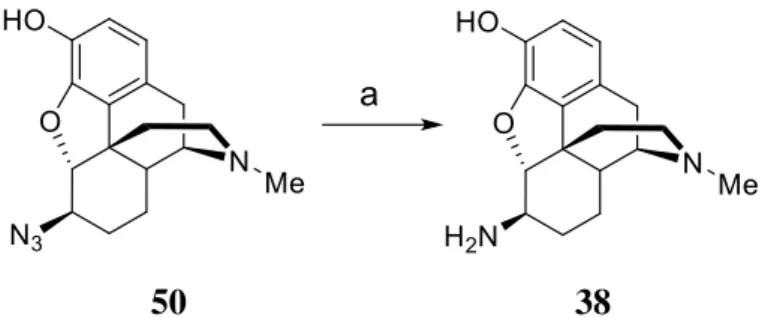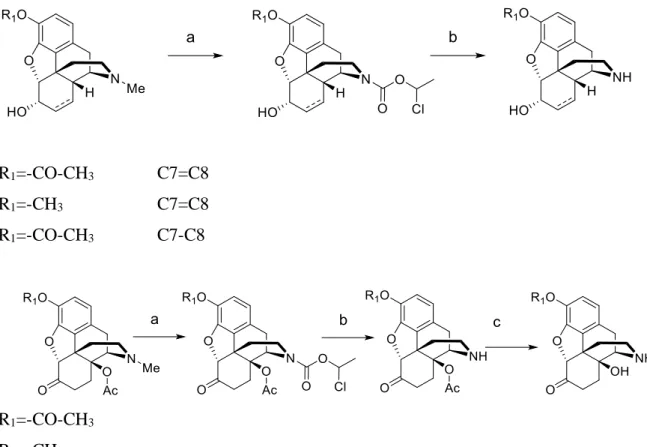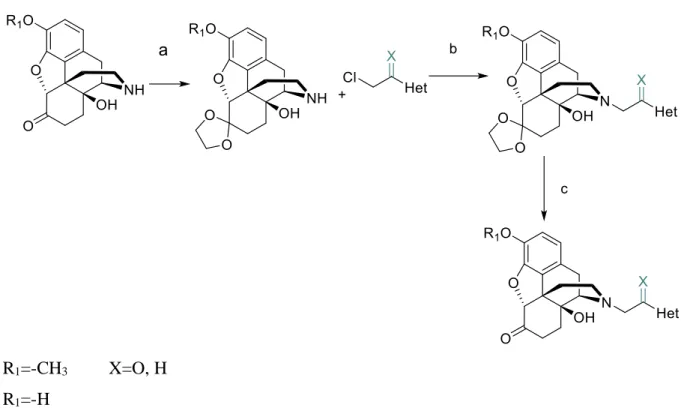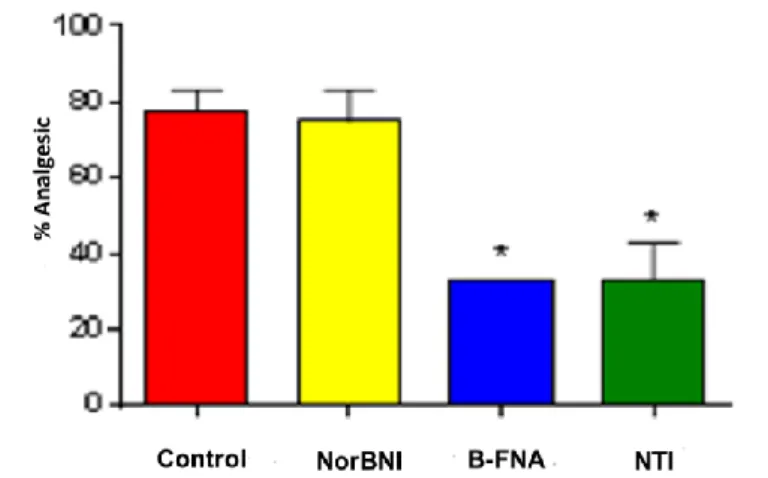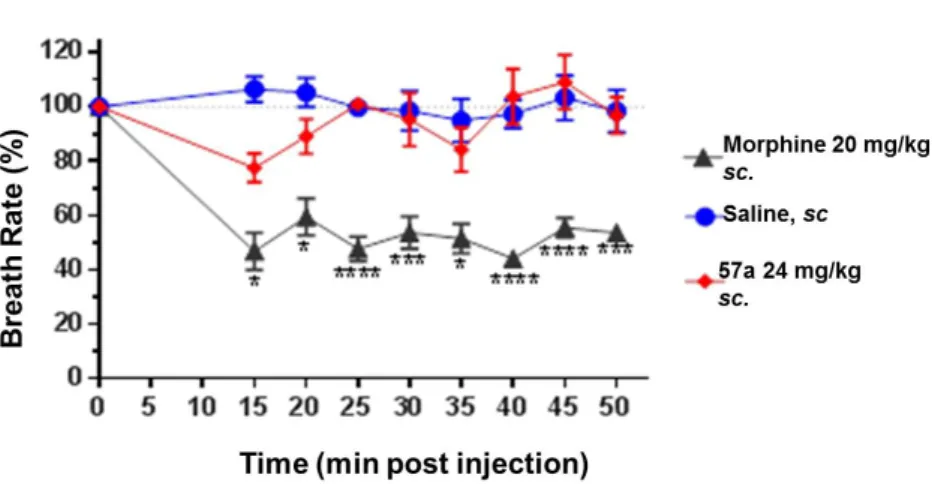Synthesis of 6β-acylaminomorphinans and N-substituted nor- compounds
PhD thesis
Urai Ákos
Pharmaceutical Sciences Doctoral School Semmelweis University
Supervisor: Sándor Hosztafi, C.Sc., senior research fellow
Opponents: Bölcskei Hedvig, C.Sc., honorary associate professor Czompa Andrea, Ph.D., assistant professor
Final exam committee:
Chairman: Tamás Török D.Sc., emeritus professor
Members: Gábor Krajsovszky Ph.D., associate professor Pál Perjési C.Sc., full professor
Budapest
2017
2 1.Introduction
The ancient Greeks knew that extracts of poppy (Papaver somniferum) had analgesic and antitussive properties. These had great importance during religious rituals. Those who consumed them felt their euphoric, narcotic, sedating and hallucinating effects.
By scratching the immature seed pod a milky substance was collected, and dried to yield a so-called cake, which was consumed in a pipe or by chewing. After the invention hypodermic syringe, it was used intravenously. In the meantime, opiates are harmful for the user. Increasing dosages of these narcotics cause physical and emotional dependence. The respiratory depression caused by opiates can lead to fatal asphyxia.
The research of opiates have always been an important subject. In 1927 Janos Kabay founded the first alkaloid chemical factory in Tiszavasvári. The extraction process developed by Kabay established the Hungarian research of alkaloids.
Based on the structure activity relationship of alkaloids of poppy several semi- synthetic derivative and synthetic analogues were introduced into clinical practice.
By studying the structure of endogenous opiate peptides new receptor specific ligands could be developed. The modern autoradiographic and immunochemical experiment can describe the distribution of receptor on the body.
Our research group decided to synthesize and study new morphine analogues based on literature data. We hoped to synthetize new compounds, which have better analgesic properties and better side effect profile than morphine. Docking and molecular modelling studies showed that introducing new 6β-amino sidechains selective MOR binding can be achieved, which is known to cause fewer side-effects, for example respiratory depression or addiction.
Based on molecular modelling a series of 6-heteroaryl naltrexamine analogues were designed and synthesized with 6 side chains including nicotinic, isonicotinic, and isoquinoline carboxylic acid amides. One of the most potent and selective to MOR of the series was the nicotinic acid derivative, NAP (6β-isonicotinic-naltrexamide) which was chosen as lead molecule for further studies. The compound was found to be a potent peripheral MOR selective antagonist based on the in vitro and in vivo pharmacological studies. β-Funaltrexamine (β-FNA), a covalent MOR-1 antagonist affinity label with partial KOR-1 agonist activity that has been widely used to investigate opioid receptor mechanisms.
3 2. Aims
The aim of our research was to synthesize new opiate analgesics, which are more potent than current drugs and have better side-effect profile.
Based on the structure of β-FNA we designed and synthesized new selective agonist cinnamylamido morphine analogues. Based on structure and modelling result of NAP we designed and synthesized new selective agonist nicotinicamido and isonicotinicamido morphine analogues.
The substituent in the C-17 position play important role in the pharmacological profile of morphinanes. Based on literature data the substitution of the N-Methyl moiety on pethidine and metazocine with β-anilino-ethyl and γ-N-propyl-phenil group increased the analgesic activity. Based on these we decided to synthesize morphinanes substituted in the C-17 position by ethyl-heterocyclic and acetyl-heterocyclic side chains.
The structure and purity of the synthesized compounds were determined by LC-MS,
1H and 13C NMR.
The pharmacological evaluation the final product was performed in cooperation with Memorial Sloan-Kettering Cancer Center.
3. Methods
All chemicals were purchased from Sigma-Aldrich Chemicals (Darmstadt, Germany) and Alfa Aesar (Ward Hill, MA) and were used without further purification. 1H and 13C NMR spectra were recorded on a Varian VNMRS spectrometer (600 MHz for 1H, 150.9 MHz for 13C) equipped with a dual 5-mm inverse-detection gradient (IDPFG) probehead. Spectra were recorded in CD3OD or CDCl3 at 25.0±0.1 °C. NMR spectra were processed with VNMRJ 2.2C and MestReNova software (ver. 6.1.1.). The high resolution accurate masses (HRMS) were determined with an Agilent 6230 time-of-flight mass spectrometer. Samples were introduced by Agilent 1260 Infinity LC system, the mass spectrometer was operated in conjunction with a Jet Stream electrospray ion source in positive ion mode. Reference masses of m/z 121.050873 and 922.009798 were used to calibrate the mass axis during analysis.
Mass spectra were processed using Agilent MassHunter B.02.00 software.
The final compounds were purified with column chromatography. The in vitro and in vivo test were performed at the Memorial Sloan-Kettering Cancer Center by Dr. András Váradi and his coworkers.
4 4. Results
4.1. Synthesis of 6β-amino morphinans
The 6β-amino derivatives of morphine and codeine were synthesized using the Mitsunobu reaction. Morphine and 14-hydroxy-dihydromorphine were selectively protected in the C-3 position with acetic anhydride and subsequently treated with phthalimide and diisopropyl azodicarboxylate (DIAD) in the presence of Ph3P. Codeine were reacted directly under the same conditions. The 6β-phthalimidoyl intermediates were isolated as HCl salts and then treated with hydrazine hydrate in ethanol to yield the desired 6β-amino derivatives. For amidation reactions, the appropriate carboxylic acids were treated with thionyl chloride and reacted with the 6β-amino compounds in dichloromethane in the presence of Et3N. In case of 6β-morphinamine formation of 3-O-esters could also be detected; the amidation reaction mixture was evaporated to dryness and dissolved in the mixture of methanol and aqueous sodium carbonate solution and left to stand overnight to ensure cleavage of C-3 phenolic esters.
R1=-CO-CH3 R2= -H C7=C8
R1=-CH3 R2= -H C7=C8
R1=-CH3 R2= -H C7-C8
R1=-CO-CH3 R2= -OH C7-C8
Figure 1. Synthesis of 6β-amino morphinans. a) benzene/ Ph3P, phthalimide, DIAD, r.t. 1 h; b) ethanol/ hydrazine monohydrate heating 4 h
4.2. Synthesis of 6β-amino-dihydromorphine.
Bognár and Makleit reported the reduction of 6-azido-dihydromorphine by lithium aluminum hydride in diethyl ether. We elaborated an efficient new method for this reduction, utilizing hydrazine and Raney nickel in ethanol. With the new method, higher yields were achieved, work-up was easier and the final product did not require further purification.
5
50 38
Figure 2. Synthesis of 6β-amino-dihydromorphine. a) hydrazine monohydrate/Raney Nickel, ethanol, r.t. 2 h
4.3. Synthesis of 6β-amido morphinans
The 6β-aminomorphinans were reacted with nicotinic acid chloride and isonicotinic acid chloride in dry dichloromethane in the presence of triethylamine to yield the appropriate 6β-amidomorphinans. The acyl chlorides were synthesized as described in the literature. In case of molecules containing a free phenolic group, the ester by-products were hydrolyzed with potassium carbonate in methanol.
R1= -H, -CH3, R2= -H, -OH
Figure 3. Synthesis of 6β-amido morphinans a) dichloromethane / acyl chloride, trimethylamine, r.t. 4 h
4.4. Synthesis of nor-4,5-epoxymorphinanes
The nor-compounds were synthesized from form codeine, dihydrocodein and 3-O- acethyl-morphine with α-chloroethyl-chloroformate and NaHCO3 base. The carbamate intermediates were hydrolyzed with hydrochloric acid in methanol. The nor-compounds were isolated as hydrochloride salts. In case of 14-O-acetyl morphinanes the acetyl group was cleaved at the last step with hydrochloric acid, and the nor-compounds were isolated as hydrochloride salt. Figure 4.
6 R1=-CO-CH3 C7=C8
R1=-CH3 C7=C8 R1=-CO-CH3 C7-C8
R1=-CO-CH3 R1=-CH3
Figure 4. Synthesis of nor-compounds: a) α-chloroethyl-chloroformate, NaHCO3, 1,2- dichlorethane, 84 ̊C, 8 h, b,c) HCl, methanol, 64 ̊C, 4 h
4.5. Synthesis of N-ethly- and N-acethyl-4,5-epoxymorphinanes
The nor-compounds were alkylated with appropriate chloro-β-ethyl-heterocycles and chloro-acetyl-heterocycles in DMF in the presence of sodium carbonate base. The reactions are summarized in Figures 5. and 6. In case of the noroxycodone and noroxymorphone ketal protecting group was used.
R1=-H C7=C8 X=O, H
R1=-CH3 C7=C8 R1=-CH3 C7-C8
7
Figure 5. Synthesis of N-ethly- and N-acethyl-4,5-epoxymorphinanes: a) Na2CO3, DMF, 70 ̊C, 10 h
R1=-CH3 X=O, H R1=-H
Figure 6. N-alkylations reactions: a) p-toluenesulfonic acid, ethylene glycol, benzene, reflux 3 h, b) Na2CO3, DMF, 70 ̊C, 10 h, c) 10% HCl 16 h, methanol
5. Biological studies
5.1. In vitro and in vivo study of 6β-cinnamoyl-amides
The compounds showed moderate to high affinity to MOR-1 with lower affinities for KOR-1 and DOR-1. Derivatives had very similar subnanomolar affinities for MOR-1 irrespective of the aryl ring substituent of the acylamino moiety, while KOR-1 binding was approximately 10-fold lower. DOR-1 receptor affinity was roughly two magnitudes lower than MOR-1 affinity. DOR-1/MOR-1 Ki ratio for 6β-cinnamoyl-morphinamide (57a) was 102.6. Cinnamoyl morphinamines in our series lacked the marked KOR-1 affinity seen with the previously reported acylated aminomorphinanes.
Next, the substances were administered to mice subcutaneously to determine their in vivo analgesic activity. Somewhat surprisingly only the unsubstituted cinnamoyl morphamine analog (57a) (ED50 3.13 ± 1.09 mg/kg) was analgesic with potency similar to that of morphine (4.96 ± 0.97 mg/kg s.c.). Despite similar affinities against MOR-1, KOR-1 and DOR-1 binding, substitution on the aromatic ring of the cinnamoyl acid eliminated the analgesic
8
activity. Thus, the in vivo active compound (57a) was selected as lead compound and further characterized. The analgesic activity of (57a) was partially reversed by both the MOR-1 selective antagonist β-FNA and the DOR-1 selective antagonist NTI but, interestingly, was insensitive to the KOR-1 selective antagonist norBNI (Figure 7).
Figure 7. Reversal of (57a) analgesia by selective antagonists
The [35S]GTPγS-binding assay was used to characterize the functional activity of (57a) on in vitro opioid transected cell lines. (57a) produced near maximum stimulation in all cell lines when compared with the MOR-1 agonist DAMGO, DOR-1 agonist DPDPE and KOR-1 agonist U50,488H suggesting that it acts as a full agonist at all three opioid receptors. (57a) showed a 25-fold and 4-fold selective potency for MOR-1 and DOR-1 over the KOR-1 in this assay which partially explains why in spite of high, nanomolar affinity for KOR-1 it does not exert KOR-mediated agonism in vivo, as shown by the in vivo behavior assay in which (57a) analgesia could be antagonized by selective MOR-1 and DOR-1 antagonists but not by KOR-1 antagonist. Since in vivo behavior is a better predictor of functional activity, it is safe to say that analgesia of (57a) is mediated by agonism at both MOR-1 and DOR-1, despite the approximately 100-fold selectivity in binding assays for MOR-1 over DOR-1.
Perhaps the most serious, potentially life-threatening side-effect of opiate therapy is respiratory depression. We tested the effect of (57a) on the respiratory rate of CD1 mice and found that at doses approximately four times the ED50 morphine (20 mg/kg) caused the expected marked respiratory depression, while after treatment with even a high, 8-times the ED50 dose of (57a) (24 mg/kg) no significant difference was found in respiratory rate compared with saline (Figure 8).
9
Figure 8. Respiratory depression by 57a in CD1 mice 5.2. In vitro and in vivo study of 6β-nicotinoyl- and isonicotinoyl-amides
Compounds show similar nanomolar affinity on MOR and much lower affinity on DOR and KOR. In all cases, the difference in MOR affinities between the compounds possessing nicotinic acid and isonicotinic acid moieties was minimal, however, there are greater differences in affinities on DOR and KOR receptors. The 6β-isonicotinoyl- (58e) and 6β-nicotinoyl-dihydromorphinamide (58f) derivatives had the highest MOR/DOR selectivity among the studied molecules.
In the [35S]GTPγS assay, all compounds were full agonists and produced higher stimulation on MOR than DAMGO ([D-Ala2, N-MePhe4, Gly-ol]-enkephalin). 6β- nicotinoyl- (58d) and 6β-isonicotinoyl-morphinamide (58c) sharing the same morphine skeleton had the highest potencies. The EC50 value on KOR was only determined for (58c), since no other analogs had considerable affinity at this receptor.
Figure 9. In vivo (mice) analgesic activity of compounds 58e and 58f
10
The antinociceptive activity of the four compounds with the highest affinity and agonism at MOR was determined supraspinally in mice in a tail flick antinociception assay. While (58c) was as potent as morphine (ED50 = 0.53 µg (0.27, 1.0)) given icv, the other three compounds were 3-4x less potent antinociceptives. Upon subcutaneous administration, the compounds did exhibit an antinociceptive response at 30 mg/kg (solubility limitations didn’t permit testing at higher doses). At this high dose, (58d) and (58c) exhibited about 30% MPE, while (58e) and (58f) exhibited ~80%MPE (Figure 9A). The antinociceptive ED50 of morphine was 2.5 mg/kg (1.8, 3.4) in the same assay. We evaluated (58e) and (58f) further. Both compounds showed exceptionally long lasting antinociception. In contrast to morphine’s 3h long antinociceptive response, the effect of (58e) and (58f) lasted more than 24 h (Figure 9B). Antinociception of both (58e) and (58f) was antagonized by β-FNA (Figure 9C), the mu selective antagonist, confirming that the antinociception is mediated by mu opioid receptors.
11 6. Conclusion
• The alkaloids of poppy and theirs semisynthetic derivatives are still widely used angesics. Based known structure activity relationship we designed and synthesized new analgesic compounds. They have selective binding and more favorable side effect profile than morphine. These compounds are potential lead compounds for new analgesic drugs.
• The 6β-amino-morphinanes were synthesized with stereoselective Mitsunobu reaction.
• In the case of 6β-amino-dihydromorphine the starting material was 6-azido- dihydromorphine which were reduced to amine with Raney Nickel and hydrazine instead of LAH.
• The 6β-amino-morphinanes were acylated with unsubstituted and substituted cinnamoylacid (nitro-, chloro-, methoxy-, trifluoromethyl-), nicotinic and isonicotinic acid chlorides.
• The purity and structure of the amides were studied with (TLC, HRMS,1H, 13C, NMR).
• In cooperation with the Memorial Sloan-Kettering Cancer Center in New York our compounds were evaluated with in vitro and in vivo tests. The effect on breathing of the most active compounds were tested in mice.
• We determined that out of the cinnamoyl amide the 6β-amino-morphine- cinnamoyl amid has selective binding to opiate receptors. This molecules (57a) is active in 0.1nM concertation the DOR-1/MOR-1 ratio is 102.6. In in vitro tests it was determined that (57a) is more potent than morphine ED50 =3,13±
1,09 mg/kg. In case of amide irreversible binding was not observed.
• The effect of (57a) on respiration was evaluated. Our compound caused less respiratory depression than morphine, while it was more potent.
• In the second part of my work nicotinic acid and isonicotonic acid amides of morphinanes were synthesized. This was achieved by the acylation of 6β- amines. The new compounds were tested same way as the cinnamoyl amides derivatives.
• Compounds containing the morphine and dihydromorphine scaffold showed selective MOR1- binding. Based on the in vitro analgesic results nicotinic and isonicotine amides of dihydromorphine were tested in vivo, in tail flick assay.
12
Both compounds showed good analgesic activity in case of (58e) at 0,7/µg/kg and in case of (58f) 1,8µg/kg dosage.
• The chosen compounds (58e) and (58f) had a very long-lasting analgesic effect for 24h, while morphine last only for 3 hours. The compound were tested against β-funaltrexamine and we can conclude that these act as full agonist on the MOR receptor.
• In the third part of my thesis I showed the synthesis of substituted morphinanes in the C-17 position. First nor-compounds were synthesized by the demethylation at the 17 position. Nordihydrocodein, norcodeine, normorphine, noroxymorphone and noroxycodone were synthetized in this manner.
• The nor-compounds were alkylated with chloro-ethyl-heterocycles and chloro- acetyl-heterocycles. We wish to study the analgesic activity of the 30 new compounds with in vitro and in vivo assays.
13
7. List of publications Publication connected to the Ph.D. thesis
1. Urai A, Varadi A, Szocs L, Komjati B, Le Rouzic V, Hunkele A, Pasternak GW, Majumdar S, Hosztafi S. (2017) Synthesis and pharmacological evaluation of novel selective MOR agonist 6β-pyridinyl amidomorphines exhibiting long-lasting antinociception. MedChemComm. 8: 152-157. IF 2,319
2. Varadi A, Hosztafi S, Le Rouzic V, Toth G, Urai A, Noszal B, Pasternak GW, Grinnell SG, Majumdar S. (2013) Novel 6β-acylaminomorphinans with analgesic activity. European Journal of Medicinal Chemistry. 69: 786-9. IF 3,982
Publication not connected to the Ph.D. thesis
1. Komjati B, Urai A, Hosztafi S, Kökosi J, Kovats B, Nagy J, Horvath P. (2016) Systematic study on the TD-DFT calculated electronic circular dichroism spectra of chiral aromatic nitro compounds: A comparison of B3LYP and CAM-B3LYP.
Spectrochimica Acta A Molecular and Biomolecular Spectroscopy. 155: 95-102.
IF 2,653

